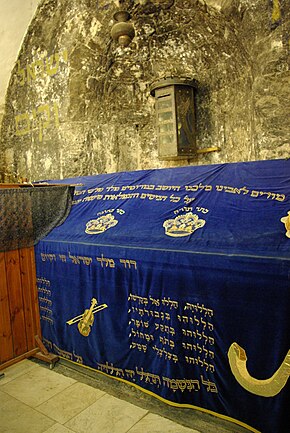David's Tomb
| Hebrew: קבר דוד המלך | |
 |
|
| Location | Jerusalem |
|---|---|
| Region | Israel |
| Coordinates | 31°46′18″N 35°13′46″E / 31.77170°N 35.22936°E |
| Type | tomb |
| History | |
| Cultures | Ayyubid, Hebrew, Byzantine, Crusaders |
King David's Tomb (Hebrew: קבר דוד המלך) is a site viewed as the burial place of David, King of Israel, according to a tradition beginning in the 12th century. It is located on Mount Zion in Jerusalem, near the Hagia Maria Sion Abbey. The tomb is situated in a ground floor corner of the remains of the former Hagia Zion, a Byzantine church. Older Byzantine tradition dating to the 4th century identified the location as the Cenacle of Jesus and the original meeting place of the Christian faith. The building is now part of the Diaspora Yeshiva.
The tomb is located in a corner of a room situated on the ground floor remains of the former Hagia Zion an ancient house of worship; the upper floor of the same building has traditionally been viewed as the Cenacle of Jesus. The site of David's burial is unknown, though the Tanakh locates it southwards, in the Ir David near Siloam. In the 4th century CE, he and his father Jesse were believed to be buried in Bethlehem. The idea he was entombed on what was later called Mt Zion dates to the 9th century CE. Writing around 1173 Benjamin of Tudela recounted a colourful story that two Jewish workers employed to dig a tunnel came across David's original splendid palace, replete with gold crown and scepter and decided the site must be his tomb. The Gothic cenotaph preserved to this day was constructed by the Crusaders: the Mount Zion conquered by David according to the Book of Samuel was wrongly ascribed by medieval pilgrims to this site, and David was presumed to be buried there.
In 1429, Mamluk Sultan Barsbay took part of the lower floor of the complex away from the Franciscans and converted the tomb chamber into a mosque. Though it was returned a year later, possession alternated back and forth until 1524 when Ottoman Sultan Sulayman (Suleiman the Magnificent) expelled the Franciscans from the entire complex. The resulting Islamic shrine was entrusted to Sufi Sheikh Ahmad Dajani and his posterity.
...
Wikipedia

